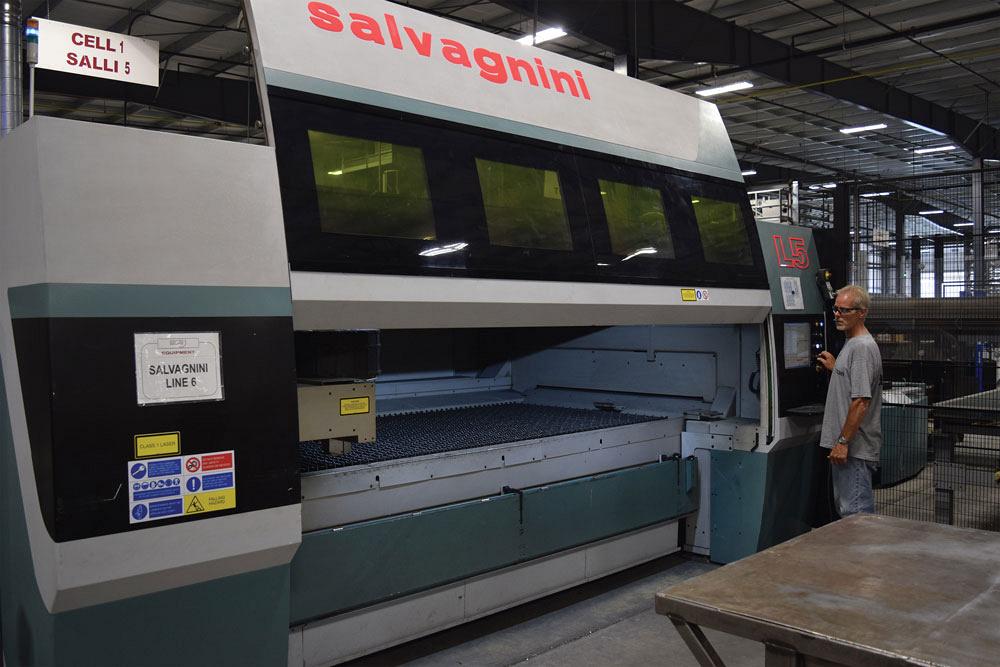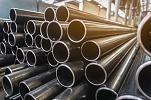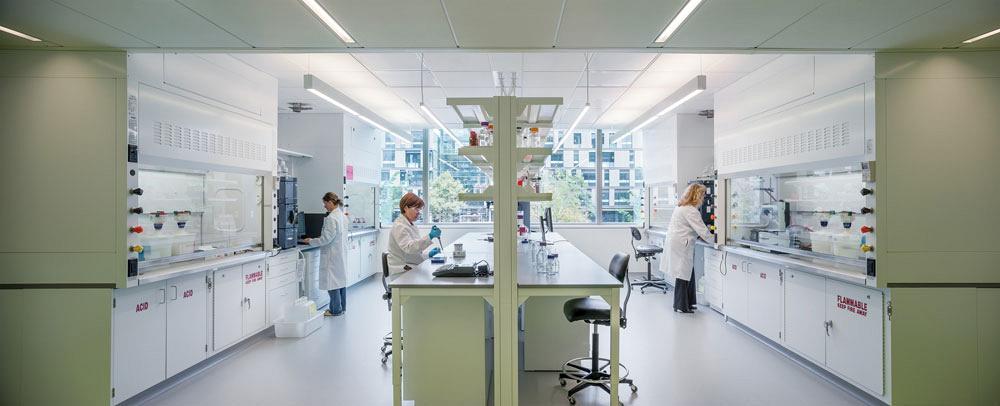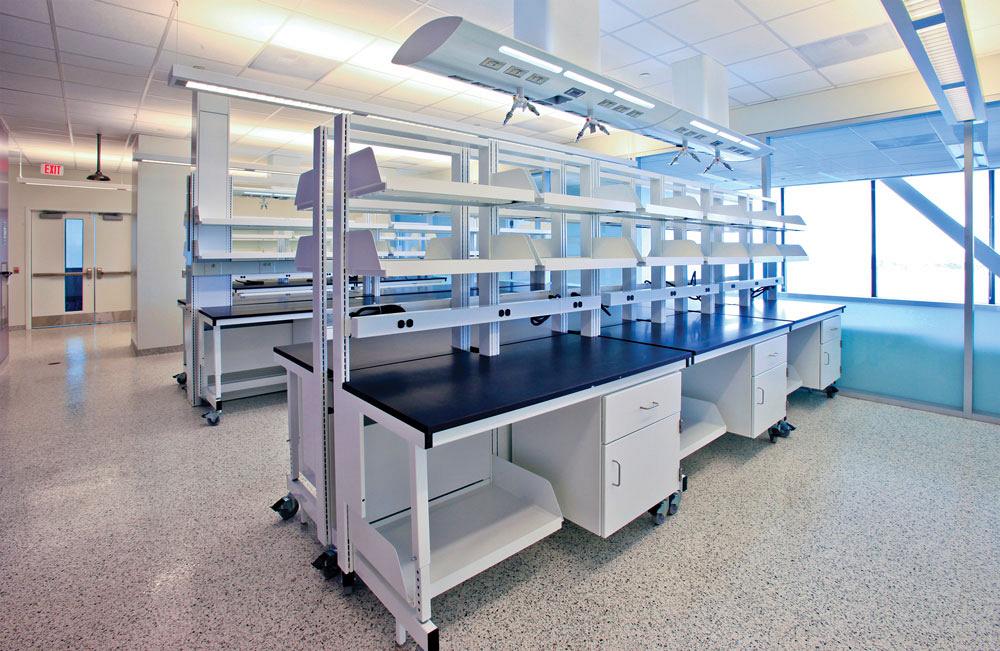Editor
- FMA
- The Fabricator
- FABTECH
- Canadian Metalworking
Finding the work flow perfection formula
Lab furniture fabricator Mott Manufacturing continues to hone its processes with software and machine upgrades
- By Rob Colman
- September 19, 2017
- Article
- Fabricating
Brantford, Ont.-based Mott Manufacturing has been a fixture in its community for 54 years. The company specializes in the design and fabrication of laboratory furniture and is one of the leaders in the field. Because each project is a custom build and must meet construction schedules set by customers, it’s essential that the fabricating floor be flexible and efficient.
Through several expansions in the past 14 years at Mott’s current facility, the company has shown how it can build and grow without missing a beat. New machinery and software investments have allowed the company to meet the demands of substantial output growth without compromising quality.
Panel Bending Benefits
Mott Manufacturing arrived at its current 12-acre location on Hardy Road in 2003. At that time they built a 100,000 sq. ft. building . Since then it has been expanded twice, in 2010 and 2015, and is currently just over 223,000 sq. ft.
All the metal used in Mott’s products – which includes everything from fume hoods to cabinets – is cut, bent, welded, and powder-coated on-site. Any wood used in cabinets or doors is supplied from Mott’s other facility in West Virginia, but the final products (including additional electrical and other components sourced externally) are assembled in-house in Brantford then shipped for installation by Mott’s well-established international dealer network.
Coordinating the flow of parts was a big concern when the company was preparing for its second expansion in 2015.
“During the first expansion, the flow of materials was considered within the constraints of existing layouts and services,” said Ryan Turcotte, Mott’s continuous improvement manager. “It was really critical for us during this most recent expansion to ensure the movement of parts was going to be streamlined as part of a larger layout realignment, as well as a consideration for additional internal growth.”
The heart of Mott’s fabrication process is its investment in combination automated storage, punching, and panel bending lines supplied by Salvagnini, known as the S4 + P4 line. It punches, shears, and bends sheet metal totally automatically. Mott’s first automated line was installed in 2005. A second was added two years later in 2007, and two more were installed in 2015.
“Many of our products use sheet steel material between 20- and 11-gauge cold-rolled steel,” said Turcotte. “The bulk of those parts are fabricated using these four lines.”
During the 2015 expansion, Mott was able to keep production rolling by first installing one of its newly acquired lines. Once it was running, one of the older lines was moved, such that two lines – the amount of production they were used to – were still operating even as the shop was being reconfigured. Now two lines share a storage tower. As sheet is required, it is transferred to a line via an automated cart that feeds the sheet into the punch. Once the punch processes the sheet, it is sent to a stacker table, which then shuttles the punched parts to the panel bender.
Panel benders work best with thin-gauge material. Because Mott works on a project-by-project basis, the other benefit is that a variety of parts necessary for that project can be punched in a single nest and processed together through the panel bender without anyone touching the parts until they are removed from the panel bender bed to be sent to welding.
“All of the production on that line is connected and sequenced with between a one-minute and two-minute cycle time per piece on the panel bender,” said Turcotte. The parts processed on the bender range in size up to 8 ft. by 6 ft. “These machines are extremely flexible and allow us to run whatever we want on the lines, whenever we want.”
The S4 punch that is integrated into this system doesn’t require stopping for tool changes, nor are automatic setup devices needed since the tools are always available. This means that all the movements required to move the sheet to the active tool are eliminated, which is part of what makes cycle times so short.
The P4 panel bender is celebrating its 40th anniversary this year. It can make bends between 0.4 mm and 3.2 mm.
Smaller parts, stainless steel parts, and steel parts that are 11 ga. or ¼-in. thick are cut on two Salvagnini L5 fibre lasers that are set up next to the punch/bend lines and fed by a separate storage tower. “We could run some of the stainless parts on the punch and the panel bender, but we can extend tooling life if we laser-cut these materials,” said Turcotte.
Cut parts from the lasers come off a conveyor and are hand-sorted from the skeleton and taken to be processed on one of the company’s eight press brakes. While the press brake department is kept busy, about 80 per cent of a standard cabinet, for instance, is processed through the automated punch/bend lines.
Future Growth Opportunities
Once parts are cut and bent they are funneled into one of the shop’s three spot welding and gas metal arc welding or gas tungsten arc welding areas. Here, workstation and bent parts meet any tube parts, which are processed in an adjacent area on a BLM Adige LT722D laser. This laser cuts up to 6 in. diameter and allows for loading lengths to 21 ft.
“Tube is used for table legs and some structural elements,” said Turcotte. “The advantage of the tube laser is that we can cut features into the tube so that the parts are self-jigging and self-locking. This reduces clamping and additional measuring during welding. It becomes simpler to pre-assemble prior to welding. Having the tube laser has really improved the speed and throughput of our workstation and table production.”
From there the parts are sent on a conveyor to be powder-coated.

Pictured here is the original P4 punch/shear/bend Salvagnini line at Mott Manufacturing. Since this first installation, three more lines have been added. The lines are fed by two storage towers. Photo courtesy of Mott Mfg.
“Because of the shop’s original configuration, the powder coating booth is at the far end of the facility, but the conveyor system is flexible enough that, should we wish to expand, it can be quickly reconfigured to meet our new layout requirements,” said Turcotte. Regardless, the parts come back along the same conveyor to enter the assembly area, which is directly adjacent to its terminus.
While its fabricating area has a substantial number of machines, there’s still room for growth. Turcotte noted that the company’s plan is likely to invest in more technology that will allow production efficiencies to increase.Software: Flow Simplification
What sets Mott apart, according to Turcotte, is the company’s willingness to work with customers to ensure that they get their project configured exactly the way they want it. Although the company has a substantial catalogue of standard items, it’s not uncommon for these standard items to be modified by customers to fit a need or simply to fit the floor space given.
Ensuring the right information gets to production, therefore, is a critical part of making timely deliveries of final product. In 2016 Mott’s software developers introduced a custom production system for the company to deal with this issue.
“From order entry to design to production, it’s a system that all talks to each other and flows through the whole facility,” said Turcotte. “Previously, keeping track of all of this required a lot of paperwork.”
Screens in each department on the production floor allow team members to see what parts should be arriving in their area – what they should be working on when, and the inputs and outputs expected to allow them to say the work has been done. Mott is an ISO-certified company, so this is a natural extension of the definition of their procedures and work instructions.
It’s from this system that all part information flows. On each shift, Mott has nesting experts on the shop floor. These individuals prep the nests for both the punches and the lasers.
The fabricating area of Mott’s operations currently runs 24/7 to keep up with production needs. Assembly runs 24 hours, five days a week.
Output Growth
All of these process and machinery upgrades have allowed the shop floor to keep up with an output growth of 20 per cent per year for the past five years. At this point, although Turcotte is constantly looking for ways in which production can be more streamlined, he understands that production can be counted on to deliver what the shop requires.

Mott also has two Salvagnini L5 fibre lasers on the shop floor fed by a separate storage tower. These lasers are used to cut thicker material.
"Right now we are working on getting order shipping processes to be leaner," Turcotte said. “Our next goal is to improve 5S activities throughout the facility,” he said.
With its strong dealer network taking care of sales across North America, and a flexible team on and off the shop floor in Brantford, Mott Manufacturing has demonstrated how a company can run a tight, efficient operation while prospering right here in Canada. A shop that employs more than 225 and a front office of 75 people is a boon to the local economy and an example to others that the right technology investments and the right innovative spirit among employees can create a winning combination.
Editor Robert Colman can be reached at rcolman@canadianfabweld.com.
Mott Manufacturing, 519-752-7825, www.mott.caAbout the Author

Rob Colman
1154 Warden Avenue
Toronto, M1R 0A1 Canada
905-235-0471
Robert Colman has worked as a writer and editor for more than 25 years, covering the needs of a variety of trades. He has been dedicated to the metalworking industry for the past 13 years, serving as editor for Metalworking Production & Purchasing (MP&P) and, since January 2016, the editor of Canadian Fabricating & Welding. He graduated with a B.A. degree from McGill University and a Master’s degree from UBC.
subscribe now


Keep up to date with the latest news, events, and technology for all things metal from our pair of monthly magazines written specifically for Canadian manufacturers!
Start Your Free Subscription- Trending Articles
BlueForge Alliance partners with Nuts, Bolts & Thingamajigs to develop Submarine Manufacturing Camps

Portable system becomes hot tech in heat treatment

Orbital tube welding webinar to be held April 23

Cidan Machinery Metal Expo 2024 to be held in Georgia May 1-2

Corrosion-inhibiting coating can be peeled off after use

- Industry Events
MME Winnipeg
- April 30, 2024
- Winnipeg, ON Canada
CTMA Economic Uncertainty: Helping You Navigate Windsor Seminar
- April 30, 2024
- Windsor, ON Canada
CTMA Economic Uncertainty: Helping You Navigate Kitchener Seminar
- May 2, 2024
- Kitchener, ON Canada
Automate 2024
- May 6 - 9, 2024
- Chicago, IL
ANCA Open House
- May 7 - 8, 2024
- Wixom, MI

















